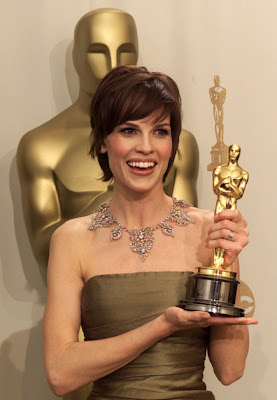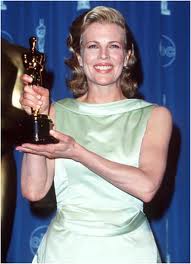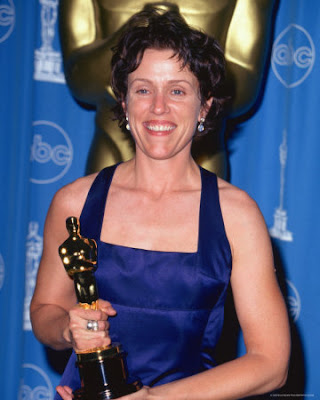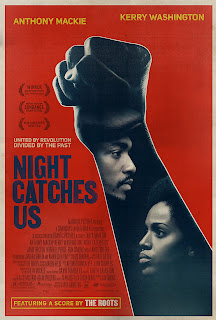Oscar Acceptance Speeches, 1999
Leading up to the 2011 Oscars, we’ll showcase the past twenty years of Oscar Acceptance Speeches by Best Actress winners and Best Supporting Actress winners. (Note: In most cases, you’ll have to click through to YouTube in order to watch the speeches, as embedding has been disabled at the request of copyright owners.)
Best Actress Nominees: 1999
Cate Blanchett – Elizabeth
Fernanda Montenegro – Central Station
Gwyneth Paltrow – Shakespeare in Love
Meryl Streep – One True Thing
Emily Watson – Hilary and Jackie
Best Supporting Actress Nominees: 1999
Kathy Bates – Primary Colors
Judi Dench – Shakespeare in Love
Brenda Blethyn – Little Voice
Rachel Griffiths – Hilary and Jackie
Lynn Redgrave – Gods and Monsters
Gwyneth Paltrow wins Best Actress for her performance in Shakespeare in Love.
Judi Dench (transcript only) wins Best Supporting Actress for her performance in Shakespeare in Love.
See nominees and winners in previous years: 1990, 1991, 1992, 1993, 1994, 1995, 1996, 1997, 1998
Oscar Acceptance Speeches, 1998
Best Actress Nominees: 1998
Helena Bonham Carter – The Wings of the Dove
Julie Christie – Afterglow
Judi Dench – Mrs. Brown
Helen Hunt – As Good As It Gets
Kate Winslet – Titanic
Best Supporting Actress Nominees: 1998
Kim Basinger – L.A. Confidential
Joan Cusack – In & Out
Minnie Driver – Good Will Hunting
Julianne Moore – Boogie Nights
Gloria Stuart – Titanic
Helen Hunt wins Best Actress for her role in As Good As It Gets.
Kim Basinger wins Best Supporting Actress for her role in L.A. Confidential.
See nominees and winners in previous years: 1990, 1991, 1992, 1993, 1994, 1995, 1996, 1997
Oscar Acceptance Speeches, 1997
Oscar Acceptance Speeches, 1996
Best Actress Nominees: 1996
Susan Sarandon – Dead Man Walking
Mira Sorvino wins Best Supporting Actress for her performance in Mighty Aphrodite.
Meryl Streep – The Bridges of Madison County
Best Supporting Actress Nominees: 1996
Joan Allen – Nixon
Mare Winningham – Georgia
See nominees and winners in previous years: 1990, 1991, 1992, 1993, 1994, 1995
Oscar Acceptance Speeches, 1995
Rosemary Harris, Tom & Viv
Oscar Acceptance Speeches, 1994
Best Actress Nominees: 1994
Holly Hunter – The Piano
Stockard Channing – Six Degrees of Separation
Best Supporting Actress Nominees: 1994
Rosie Perez – Fearless
Winona Ryder – The Age of Innocence
Emma Thompson – In the Name of the Father
Oscar Acceptance Speeches, 1993
Judy Davis, Husbands and Wives
Quote of the Day: Susan J. Douglas
 |
| Enlightened Sexism: The Seductive Message that Feminism’s Work is Done by Susan J. Douglas |
Note: all boldface is my emphasis, not the author’s.
Today, feminist gains, attitudes, and achievements are woven into our cultural fabric. So the female characters created by Shonda Rhimes for Grey’s Anatomy, to choose just one example, reflect a genuine desire to show women as skilled professionals in jobs previously reserved for men. Joss Whedon created Buffy the Vampire Slayer because he embraced feminsim and was tired of seeing all the girls in horror films as victims, instead of possible heroes. But women whose kung fu skills are more awesome than Jackie Chan’s? Or who tell a male coworker (or boss) to his face that he’s less evolved than a junior in high school? This is a level of command-and-control barely enjoyed by four-star generals, let alone the nation’s actual female population.But the media’s fantasies of power are also the product of another force that has gained considerable momentum since the early and mid-1990s: enlightened sexism. Enlightened sexism is a response, deliberate or not, to the perceived threat of a new gender regime. It insists that women have made plenty of progress because of feminism–indeed, full equality has allegedly been achieved–so now it’s okay, even amusing, to resurrect sexist stereotypes of girls and women. After all these images (think Pussycat Dolls, The Bachelor, Are You Hot?, the hour-and-a-half catfight in Bride Wars) can’t possibly undermine women’s equality at this late date, right? More to the point, enlightened sexism sells the line that it is precisely through women’s calculated deployment of their faces, bodies, attire, and sexuality that they gain and enjoy true power–power that is fun, that men will not resent, and indeed will embrace. True power here has nothing to do with economic independence or professional achievement (that’s a given): it has to do with getting men to lust after you and other women to envy you. Enlightened sexism is especially targeted to girls and young women and emphasizes that now that they “have it all,” they should focus the bulk of their time and energy on their appearance, pleasing men, being hot, competing with other women, and shopping.
Enlightened sexism is a manufacturing process that is produced, week in and week out, by the media. Its components–anxiety about female achievement; a renewed and amplified objectification of young women’s bodies and faces; the dual exploitation and punishment of female sexuality; the dividing of women against each other by age, race, and class; rampant branding and consumerism–began to swirl around in the early 1990s, consolidating as the dark star it has become in the early twenty-first century. Some, myself included, have referred to this state of affairs and this kind of media mix as “postfeminist.” But I am rejecting this term. It has gotten gummed up by too many conflicting definitions. And besides, this term suggests that somehow feminism is at the root of this when it isn’t–it’s good, old-fashioned, grade-A sexism that reinforces good, old-fashioned, grade-A patriarchy. It’s just much better disguised, in seductive Manolo Blahniks and an Ipex bra.
Susan J. Douglas is the author of Where the Girls Are, The Mommy Myth
, and other works of cultural history and criticism. Her work has appeared in The Nation, The Progressive, Ms., The Village Voice, and In These Times. (taken from the jacket cover of Enlightened Sexism)
Guest Writer Wednesday: Night Catches Us
This guest post first appeared at Arielle Loren, daily musings for ladies and curious men.
Seeing My Reflection In Film: Night Catches Us Struck a Chord With Me
Based in Philadelphia, Night Catches Us tells the story of two former black panthers trying to re-establish life after leaving The Party and the death of a fellow panther years ago. While the central plot revolves around these two characters’ lives, Hamilton integrates into the film historic footage of the Black Panther Party. As this era of black history often is pigeonholed to radicalism, Hamilton truly humanizes The Party through several scenes of police brutality, corruption, and community gatherings. For instance, Washington’s character, Patricia, would raise money to pay the legal fees for her less fortunate clients and feed every child on the block even when she couldn’t pay her light bill.
This sentiment of “community first” is the history with which I identify and the one that I wish we could spread to more mainstream screens. While watching this film, I saw my reflection. From Washington’s afro to her desire to serve her community, I felt hope again for the half-baked images rummaging through mainstream black film. Night Catches Us only is playing in select theaters, BUT you can rent it on iTunes and On Demand via Comcast. Thus, there’s no excuse not to support this film; we’ve got to support the films that we want to see in the mainstream.
Check out the trailer for Night Catches Us below and if you haven’t seen the film, view it on iTunes. Tell me, how can we get more films like this onto the big screen?
The Fat Body (In)Visible
Rabin describes the Fatosphere as follows:
She continues:
Quotes from the documentary: Keena, on Fat Acceptance: Fat acceptance is just accepting your body where it is at. Whether you’re bigger or you’re smaller. Just accepting what it is, your arms, your double chin, your thighs, and just not worrying about how other people may view you.The bloggers’ main contention is that being fat is not a result of moral failure or a character flaw, or of gluttony, sloth or a lack of willpower. Diets often boomerang, they say; indeed, numerous long-term studies have found that even though dieters are often able to lose weight in the short term, they almost always regain the lost pounds over the next few years.
Fat acceptance bloggers contend that the war on obesity has given people an excuse to wage war on fat people and that health concerns—coupled with the belief that fat people have only themselves to blame for being fat—are being used to justify discrimination that would not be tolerated toward just about any other group of people.
Jessica, on Fat Acceptance: Fat acceptance is just the radical idea that every body is a good body and that regardless of your shape or your size that you deserve just as much respect as the next person.
Ripley’s Pick: The No. 1 Ladies’ Detective Agency
 |
| The No. 1 Ladies’ Detective Agency |



























